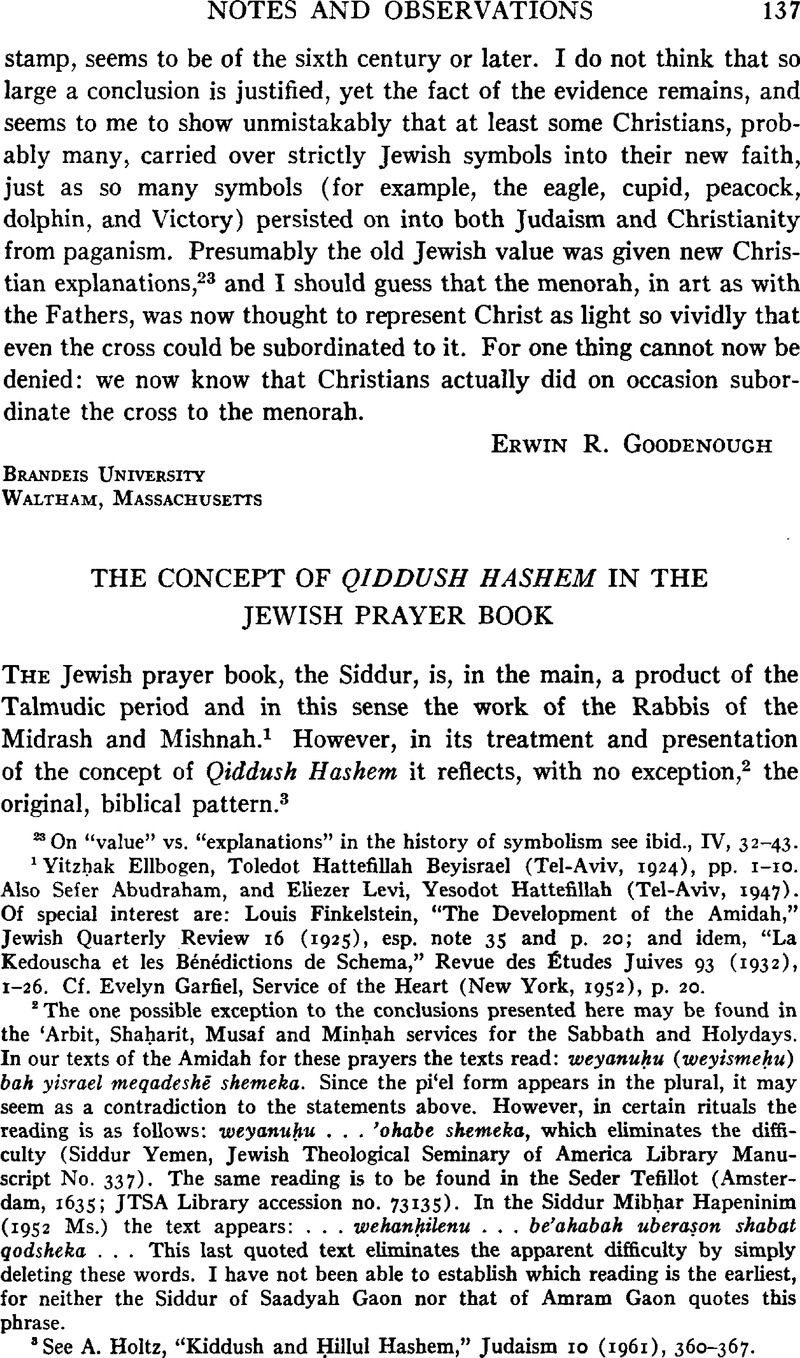No CrossRef data available.
Article contents
The Concept of Qiddush Hashem in the Jewish Prayer Book
Published online by Cambridge University Press: 23 August 2011
Abstract

- Type
- Notes & Observations
- Information
- Copyright
- Copyright © President and Fellows of Harvard College 1964
References
1 Yitzḥak Ellbogen, Toledot Hattefillah Beyisrael (Tel-Aviv, 1924), pp. 1–10. Also Sefer Abudraham, and Eliezer Levi, Yesodot Hattefillah (Tel-Aviv, 1947). Of special interest are: Louis Finkelstein, “The Development of the Amidah,” Jewish Quarterly Review 16 (1925), esp. note 35 and p. 20; and idem, “La Kedouscha et les Bénédictions de Schema,” Revue des Études Juives 93 (1932), 1–26. Cf. Evelyn Garfiel, Service of the Heart (New York, 1952), p. 20.
2 The one possible exception to the conclusions presented here may be found in the ‘Arbit, Shaḥarit, Musaf and Minḥah services for the Sabbath and Holydays. In our texts of the Amidah for these prayers the texts read: weyanuḥu (weyismeḥu) bah yisrael meqadeshē shemeka. Since the piʻel form appears in the plural, it may seem as a contradiction to the statements above. However, in certain rituals the reading is as follows: weyanuḥu … ʼohabe shemeka, which eliminates the difficulty (Siddur Yemen, Jewish Theological Seminary of America Library Manuscript No. 337). The same reading is to be found in the Seder Tefillot (Amsterdam, 1635; JTSA Library accession no. 73135). In the Siddur Mibḥar Hapeninim (1952 Ms.) the text appears: … wehanḥilenu … beʼahabah uberaṣon shabat godsheka … This last quoted text eliminates the apparent difficulty by simply deleting these words. I have not been able to establish which reading is the earliest, for neither the Siddur of Saadyah Gaon nor that of Amram Gaon quotes this phrase.
3 See Holtz, A., “Kiddush and Ḥillul Hashem,” Judaism 10 (1961), 360–367.Google Scholar
4 Ibid., 361.
5 Sanhedrin 74 a and b; Yerushalmi Abodah Zarah 27b; Mishnah Shebi'it 4:2.
6 Max Kadushin, The Rabbinic Mind (New York, 1952), pp. 44ff.
7 It follows from the summary of the biblical view of this concept that in the Bible QDŠ cannot appear in the piʻel plural, for God alone can sanctify His name. The same root can appear in the hifʻil plural, for the angels and the people Israel can be maqdishim. In the Rabbinic view, however, the piʻel form can be used in the plural, for in their applications Israel can and is meqadeshim. (On the unique usage in Deut. 32:51 and Num. 20:12, 27:14 regarding Moses and Aaron, see my article, p. 366 and note 24 there.)
8 Max Kadushin, The Theology of Seder Eliahu (New York, 1932), p. 165, note 164, and p. 149, note 162; idem, Organic Thinking (New York, 1938), p. 63. Cf. Garfiel, op. cit., pp. 78ff.
9 Philip Birnbaum, Ha-Siddur Ha-Shalem (New York, 1949), pp. 84 and 162.
10 Siddur Tefillat Yeshurun [Yemenite ritual] (Jerusalem, 1949), p. 71, and Nusaḥ Italy, Bet Tefillah [Padua ritual] (Liverna, 1948).
11 Cf. Isa. 29:23, in which both verbs appear and apparently served as the pattern for the author of the Qedushah.
12 “Qadosh, Qadosh …” from Isa. 6:3 and “Baruk Shem …,” Ezek. 3:12.
13 Translated by Birnbaum: “We revere and sanctify thee …”
14 Birnbaum, op. cit., p. 25.
15 Cf. Holtz, op. cit., 361.
16 Birnbaum, op. cit., p. 454.
17 See, too, the Qedushah in the Shaḥarit services before the Qeriʼat Shema, R. A. Prayer Book, p. 44, and Birnbaum, p. 73. Once again the hifʻil form is used in the reference to the angels.
18 At the end of all the Qedushot the texts read: qedushateka naqdish, which further supports our thesis.




